Scottish economic bulletin: November 2024
Provides a summary of the latest key economic statistics, forecast and analysis on the Scottish economy.
Labour Market
Unemployment fell to 3.9% while real terms earnings growth remains robust.
Employment, Unemployment, and Inactivity
- Scotland’s labour market has performed strongly at a headline level going into the second half of the year, with low unemployment and steady recovery in real earnings, however there are indications it has loosened slightly compared to 2023.
- Latest Labour Force Survey data for June to August show that Scotland’s unemployment rate fell 0.9 percentage points over the quarter and 1.0 p.p over the year to 3.9% while the employment rate rose 0.8 p.p over the quarter and fell 0.5 p.p over the year to 73.7%. The inactivity rate has decreased over the quarter (0.1 p.p) but increased over the year (1.2 p.p) to 23.2%.[14]
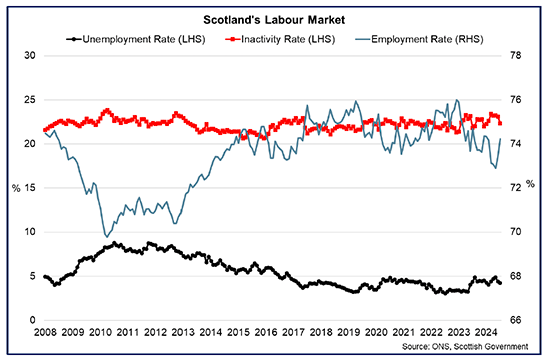
- Wider labour market data continues to illustrate underlying resilience. In September, the number of payrolled employees in Scotland decreased slightly over the month to 2.46 million, though is up 0.2% over the past year. Alongside this, Scotland’s claimant count unemployment rate increased slightly in September to 4% (up from 3.9% in August) with the number of claimants (115,881) increasing by 7,883 over the year.[15],[16]

Recruitment Activity
- Recruitment activity gradually stabilised in 2023 following the sharp spike during 2021 and 2022 as the economy was recovering from the pandemic.
- In October 2024 online job adverts continued to stabilise, having fallen 30% over the past year (and from their generally elevated levels in 2022 and 2023) indicating slight loosening in labour market conditions over the past year. Online job adverts are now broadly in line (-0.6%) with their level in February 2020 prior to the pandemic.[17]
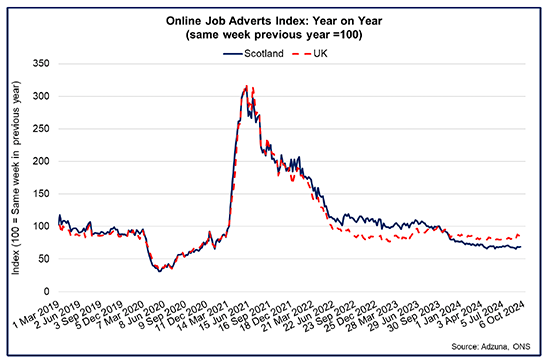
- Labour market challenges continue to be identified by businesses, with business surveys indicating recruitment difficulties and worker shortages across different sectors. Latest BICS data for October shows that 26.5% of businesses were experiencing recruitment difficulties and 25% were facing worker shortages. While these figures are not as high as they were at their recent peaks in 2023, they have increased slightly from earlier in the year.
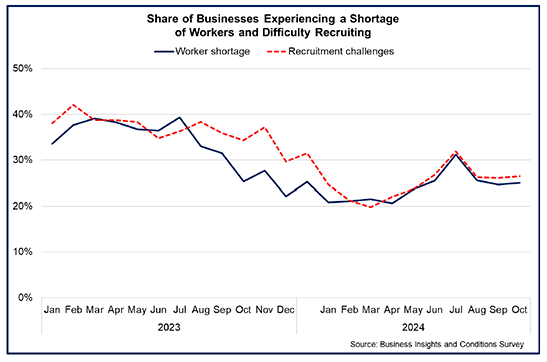
- At a sectoral level, worker shortages and recruitment difficulties in September were particularly concentrated in Accommodation and Food services, Admin and Support services and in Manufacturing. In contrast, employers in the Arts, Entertainment and Recreation, and in the Information and Communication sector, were notably less likely to report these challenges.
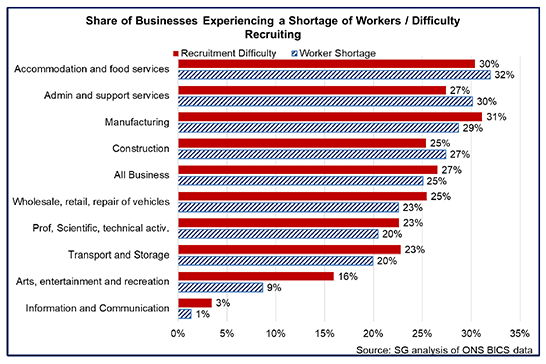
- Latest data from July show most businesses responded that a lack of qualified applicants (46.9%) alongside a low number of applications (37.7%) underpinned their recruitment challenges, while 12% of businesses felt their business could not offer an attractive pay package to applicants.
Earnings
- Despite indications that the labour market has loosened over the past year, the pace of earnings growth has remained robust. Coupled with the fall in inflation rate, this has resulted in earnings continuing to grow steadily in real terms.
- Nominal median monthly PAYE pay in Scotland was £2,441 in September, up 4.9% over the year and is above the average annual growth rate over the past nine years (4.2%), having slowed from higher rates of growth of around 8% in 2023.[18]
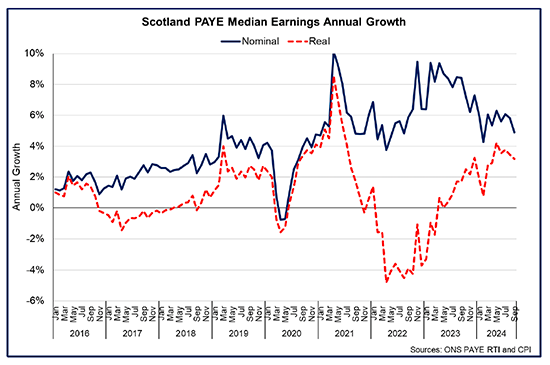
- Adjusting for inflation, which was 1.7% in September, real median earnings grew 3.2% on an annual basis. This continued the current pattern of positive annual real terms growth since second quarter of 2023 following the period of falling real pay during 2022 and the start of 2023.
Contact
Email: economic.statistics@gov.scot
There is a problem
Thanks for your feedback